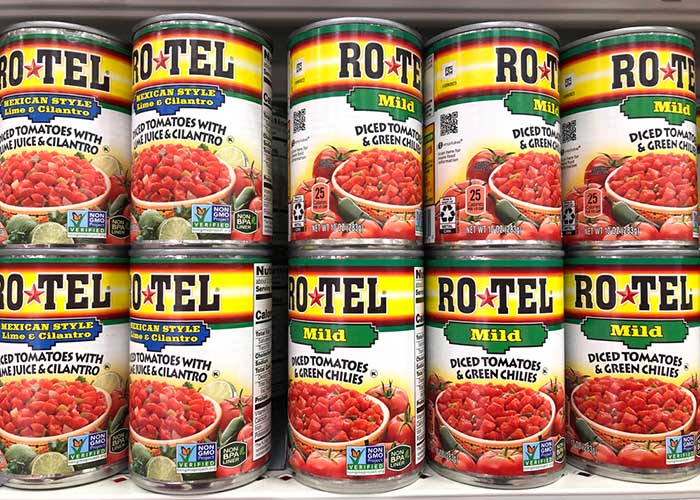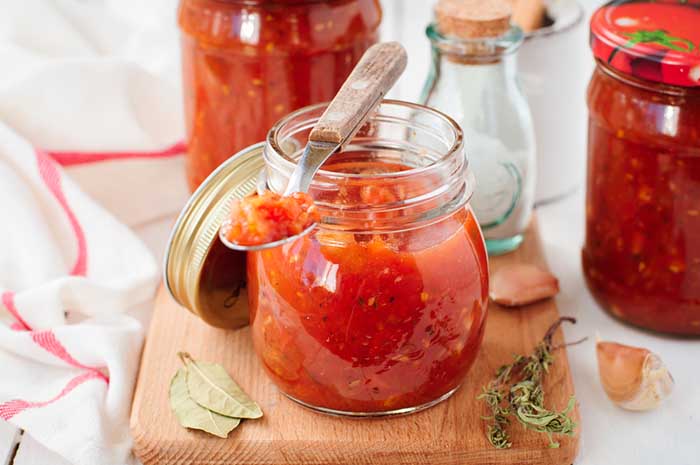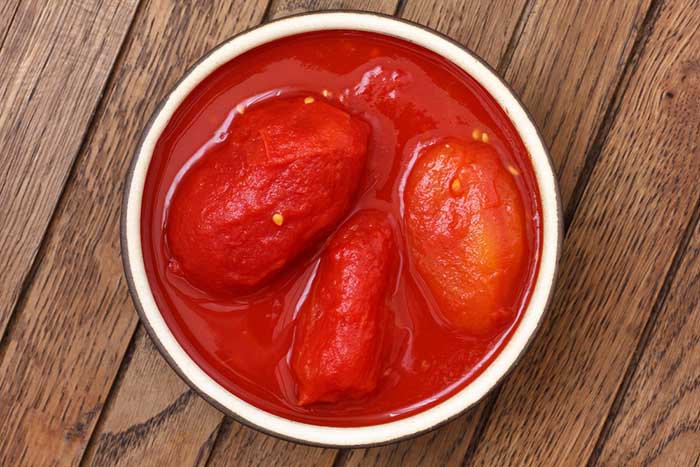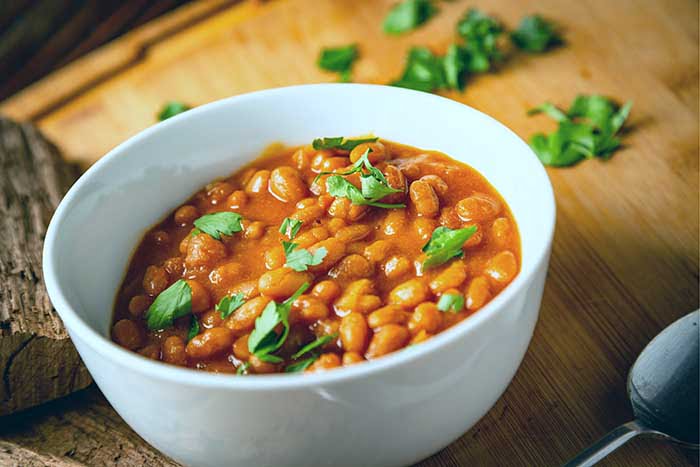The best stewed tomato substitutes for your homemade pasta sauces, casseroles, and soups. From tomato paste to purée, these are the best alternatives to use today.

Stewed tomatoes are fresh tomatoes that have been peeled and cooked to perfection with salt and seasoning. They’re a staple ingredient in every kitchen, as many recipes like soups, sauces, and stews call for them. Stewed tomatoes typically include bell peppers, garlic, onion, and celery. You don’t even need a recipe to eat them – heat them and eat them as is.
But what if you’re in the middle of cooking and realize that you don’t have stewed tomatoes on hand? Being in this situation can feel like a disaster, as they’re an essential component of many dishes. The good news is that you don’t have to panic and run to the store. It’s pretty easy to substitute stewed tomatoes by making a few simple modifications.
So what are the substitutes for stewed tomatoes? Today you will learn several ways to repurpose other common kitchen ingredients for tomatoes, which should help you if you’re in a pinch.
It is difficult to say which stewed tomato substitute is best, as many of these delicious foods can stand in place of this ingredient. Diced tomatoes, crushed tomatoes, tomato paste, whole canned tomatoes, and tomato puree all work. The flavor profile of each is similar, and these products are easy to liven up with herbs. Each of these substitutes pairs well in several recipes that require stewed tomatoes, and you likely have a can of one (or more) of them on hand.
Diced Tomatoes

Diced tomatoes are small, squarish chunks of tomatoes. They are sliced, then canned with their juice to keep them from dehydrating. You can find diced tomatoes plain or lightly seasoned, and some are even roasted to add a deeper flavor to your dishes. You probably reach for them over and over when making other recipes.
And lucky for you, diced tomatoes make an excellent substitute for stewed tomatoes in pretty much any context. Diced tomatoes are right at home in stews, pasta, soups, and many other recipes, making them quite versatile. They also don’t require much thought, as you can use them in a 1:1 ratio.
However, it’s vital to keep some differences in mind before swapping stewed tomatoes for diced tomatoes. One is that diced tomatoes are typically cut into smaller chunks than stewed tomatoes are. They’re also cooked for less time and not simmered like stewed tomatoes. You may want to cook your diced tomatoes longer and add some extra seasoning.
Crushed Tomatoes

People often refer to diced tomatoes and crushed tomatoes interchangeably, but they’re different things. As the name indicates, the tomatoes get crushed until their texture becomes smooth. Manufacturers then add tomato puree or tomato paste for an even finer texture. You get a soft, broken-down consistency that resembles that of stewed tomatoes.
The texture and size of crushed tomatoes are very similar to stewed tomatoes. And because the flavor is also comparable, crushed tomatoes make an excellent alternative. It’s probably one of the closest substitutes you can make. Just swap in your crushed tomatoes for stewed tomatoes in a 1:1 ratio.
Though crushed tomatoes have a bit more flavor thanks to the added tomato paste, you’ll likely want to add some spices and vegetables to recreate the taste of stewed tomatoes. Keep in mind that the consistency might vary a bit depending on what brand you use, but in general, crushed tomatoes work very well in creamy soups and pasta sauces.
Tomato Paste

Tomato paste is essentially highly concentrated tomato sauce. Making tomato paste involves cooking tomatoes for several hours until most of the water is gone and the tomatoes have achieved a thick texture. Then it’s pureed until it has a smooth consistency. The finished product has no seeds, skins, or chunks of tomato.
Because it’s like a puree, tomato paste might not come to mind as a substitute for stewed tomatoes. But if it’s all you have, feel free to throw it into your soups and meat dishes. The tomato paste will help enhance the dish’s flavor and consistency by adding brightness and depth.
You can use it as is, or if you want to boost the taste, try adding extra vegetables to your tomato paste. Onion, bell pepper, and celery work the best.
Keeping the conversions in mind is vital if you plan to use this stewed tomato substitute. Tomato paste is super concentrated, which can enrich a dish when used properly. But add too much tomato paste, and you risk overpowering other flavors. Try measuring a cup of tomato paste to three cups of stewed tomatoes; the dish should taste delicious.
Rotel Tomatoes

Rotel tomatoes originated in Texas. The name refers to small diced tomatoes prepared with diced chiles and sold in cans. They’re popular in dishes like sauces, quesos, casseroles, and some soups. Rotel tomatoes are generally interchangeable in dishes with diced tomatoes, which some people prefer for extra flavor.
Does your recipe call for a little extra heat? If so, Rotel tomatoes can be an excellent substitute for stewed tomatoes. They work beautifully in spicy dishes like salsa and dip recipes, as their flavor profile is very similar to that of stewed tomatoes. Feel free to add them in a 1:1 ratio for the best results.
A word of caution, be mindful of how you use Rotel tomatoes. It’s easy to forget that they’re spicy, and you don’t want to end up with a hot pasta dish when you’re trying to feed your young children.
Tomato Puree

You can also substitute tomato puree for stewed tomatoes. Tomato puree is essentially a canned sauce made by cooking and straining tomatoes. All the skins and seeds get removed, resulting in a bright, beautiful flavor. Many manufacturers make it using tomato paste and water!
However it’s made, tomato puree is usually thinner than stewed tomatoes, but it works just as well. The consistency is somewhere between tomato paste and tomato sauce. You can substitute it in almost any recipe that calls for stewed tomatoes because the only noticeable difference is the thickness.
And just like we talked about with tomato paste, it’ll help develop and enhance the flavor of your dishes in the same way. But please remember that most tomato purees lack herbs or seasonings. Depending on the recipe, you may need to add onion, pepper, and meat to pump up the flavor.
Ratios are critical when substituting tomato puree for stewed tomatoes. You’ll need slightly less than what the recipe calls for, with a ratio of about 1:⅔ being ideal. So if your recipe calls for a cup of stewed tomatoes, substitute them for ⅔ cup of tomato puree. Cook as usual, and you won’t have missed your stewed tomatoes at all!
Whole Canned Tomatoes

As you may have guessed from their name, whole canned tomatoes are just that: tomatoes that have been peeled and then packed in tomato juice or tomato puree. Most manufacturers use plum tomatoes, which are more rigid than other tomato varieties and help them keep longer in the can.
It’s always nice to have whole canned tomatoes on hand. They’re one of the highest quality tomato products, and because canned tomatoes contain juice, you can use them in a wide range of recipes that call for stewed tomatoes. Use them in all your soups, pasta, and even pizzas.
Another thing that makes them so fantastic is that whole canned tomatoes are essentially a blank canvas with which to work. You pull them out of the can intact, which allows you to adjust them to the size and shape you need. Chop them or crush them according to the dish specifications, and you’re good to go.
Our recommendation? Add a little green bell pepper and onion to give your canned tomatoes a delicious flavor, then go ahead and substitute them using a 1:1 ratio.
Fresh Tomatoes

Our final tip is for anyone who’s got some extra ripe tomatoes on hand. If so, you can whip up some homemade stewed tomatoes. This option won’t be for everyone, as it requires more work than using another substitute on this list–plan for about an hour of prep and cooking time. However, it’s a fun way to use up those extra tomatoes.
Another advantage to making stewed tomatoes is that you can customize them to your liking. If you’re an innovative chef, you’ll probably even have some fun with this tip. Not to mention, you know what’s going on in your food, and you can find plenty of recipes online.
So what will you need? Recipes vary, but in general, you’ll need three or four large fresh tomatoes. This amount makes roughly a 14.5-oz can. If you want more bang for your buck (or effort, as it were), six to eight tomatoes make around a 28-oz can.
Other ingredients to have on hand are things you already have in your pantry: salt, pepper, butter, and sugar. You might also want to add onion, meat, and celery, which you’ll cook for around twenty-five to thirty minutes. Once finished, use your homemade stewed tomatoes in a 1:1 ratio.
Honorable Mentions
If you find yourself in a pinch for a stewed tomato substitute not mentioned above, these delicious pre-made meal staples also work.
- Tomato soup has a hearty or creamy flavor but thinner consistency than stewed tomatoes. Substitute ¾:1 cup (soup: stewed tomatoes).
- Spaghetti sauce can be rich, tangy, or sweet in flavor, depending on the brand. Substitute in a 1:1 ratio.
- Salsa has a similar flavor and similar ingredients to stewed tomatoes. Substitute in a 1:1 ratio.
- Roasted peppers are a non-tomato substitute. Best for dishes requiring a savory flavor (pizzas, pasta sauces). Substitute at ¾:1 cup (bell peppers: stewed tomatoes).



